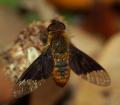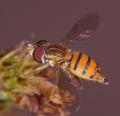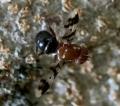Diptera.info :: Identification queries :: Diptera (adults)
Who is here? 1 guest(s)
|
Stratiomyidae - Chloromyia formosa (male)
|
|
| digitalg |
Posted on 14-08-2006 10:05
|
|
Member Location: Portugal Posts: 51 Joined: 31.07.06 |
I'm risking this family not so much about the looks of the fly but also for its behaviour. Usually sunbathing in low grass or even in the ground (that's why I was not able to get a lateral view) with closed wings. 9-10mm long, Portugal center, crop field, 2003/05/01 digitalg attached the following image: 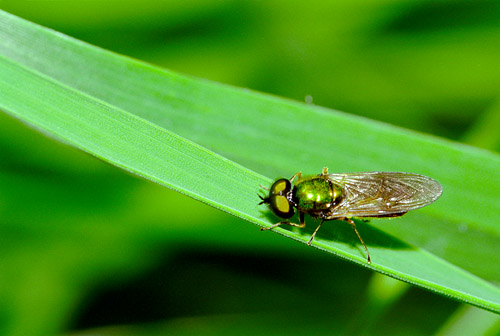 [49.03Kb] Edited by digitalg on 14-08-2006 14:35 Armando Fraz�o http://bugs.digit... |
| digitalg |
Posted on 14-08-2006 10:07
|
|
Member Location: Portugal Posts: 51 Joined: 31.07.06 |
Another of the same species, the day after. This openwing display is very rare on these flies, so I decided to take another upper view. digitalg attached the following image: 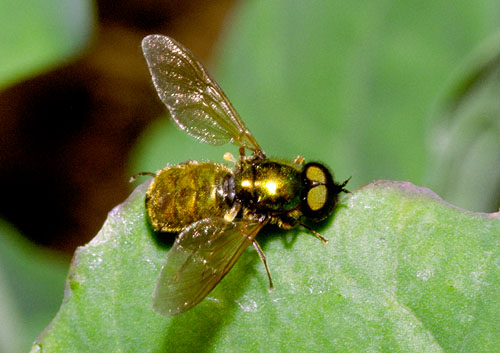 [51.78Kb] Armando Fraz�o http://bugs.digit... |
| paqui |
Posted on 14-08-2006 10:40
|
|
Member Location: Valencia (spain) Posts: 816 Joined: 02.09.05 |
Chloromyia maybe |
|
|
|
| Susan R Walter |
Posted on 14-08-2006 12:27
|
|
Member Location: Touraine du Sud, central France Posts: 1802 Joined: 14.01.06 |
Chloromyia formosa for sure - male. Metallic, hairy all over eyes, thorax and abdomen, abdomen widening at the rear end to be wider than the top and the thorax. Susan |
| digitalg |
Posted on 15-08-2006 16:19
|
|
Member Location: Portugal Posts: 51 Joined: 31.07.06 |
Thank you both 
Armando Fraz�o http://bugs.digit... |
| Susan R Walter |
Posted on 17-08-2006 13:08
|
|
Member Location: Touraine du Sud, central France Posts: 1802 Joined: 14.01.06 |
Tony's comments on the C speciosa thread made me return to this one. I happily identified this as C formosa partly on the grounds that Fauna Europaea lists C speciosa as absent from Portugal. It is clearly present in Spain though, and in France. Is Fauna Europaea wrong? If it isn't, is it common that species are absent from Portugal but occur in Spain, or vice versa? Having said that, from what I can see in the photos, I think the hind tarsi are dark enough to qualify as C formosa. The wings are tinted, but I find that the C formosa here in Essex, especially this year, generally have tinted wings. Unfortunately can't tell on these photos what colour the hair above the antennae really is. Susan |
| Paul Beuk |
Posted on 17-08-2006 13:35
|
|
Super Administrator Location: Netherlands Posts: 19403 Joined: 11.05.04 |
Susan R Walter wrote: Is Fauna Europaea wrong? I'd rather say it is incomplete. 
Paul - - - - Paul Beuk on https://diptera.info |
| digitalg |
Posted on 17-08-2006 13:37
|
|
Member Location: Portugal Posts: 51 Joined: 31.07.06 |
These photos have more than 3 years now. This year I didn't have much chance of observing these flies and I have not been really looking for them anyway. And if C. speciosa exists in Spain, unless it's has been only reported to the very east part of Spain, I don't see a strong reason it should not be also present in Portugal. There's no big obstacles in the way and ... well, sometime ago I sent a few spiders to a friend and one that he IDed should not be on that place, but it was, it just had not been recorded. That said, what colour should the hair be to make it speciosa or formosa? I might go for a few days in september to that place again and I might pay closer attention to details 
Armando Fraz�o http://bugs.digit... |
| Tony Irwin |
Posted on 17-08-2006 16:15
|
|
Member Location: Norwich, England Posts: 7282 Joined: 19.11.04 |
Hi Armando I think you're right - these are formosa. Apart from the yellow hind tarsi and the more darkened wings, speciosa is a little larger than formosa, and the hairs on the head are longer and denser and all black (at least in the males - the females have some pale hairs on the vertex, ocellar triangle and posteroventral area - but much less than in formosa). C. speciosa has been found at Empalme in Spain, which is quite close to Portugal, so I think you will find it soon! 
Edited by Tony Irwin on 17-08-2006 16:16 Tony ---------- Tony Irwin |
|
|
|
| Jump to Forum: |


